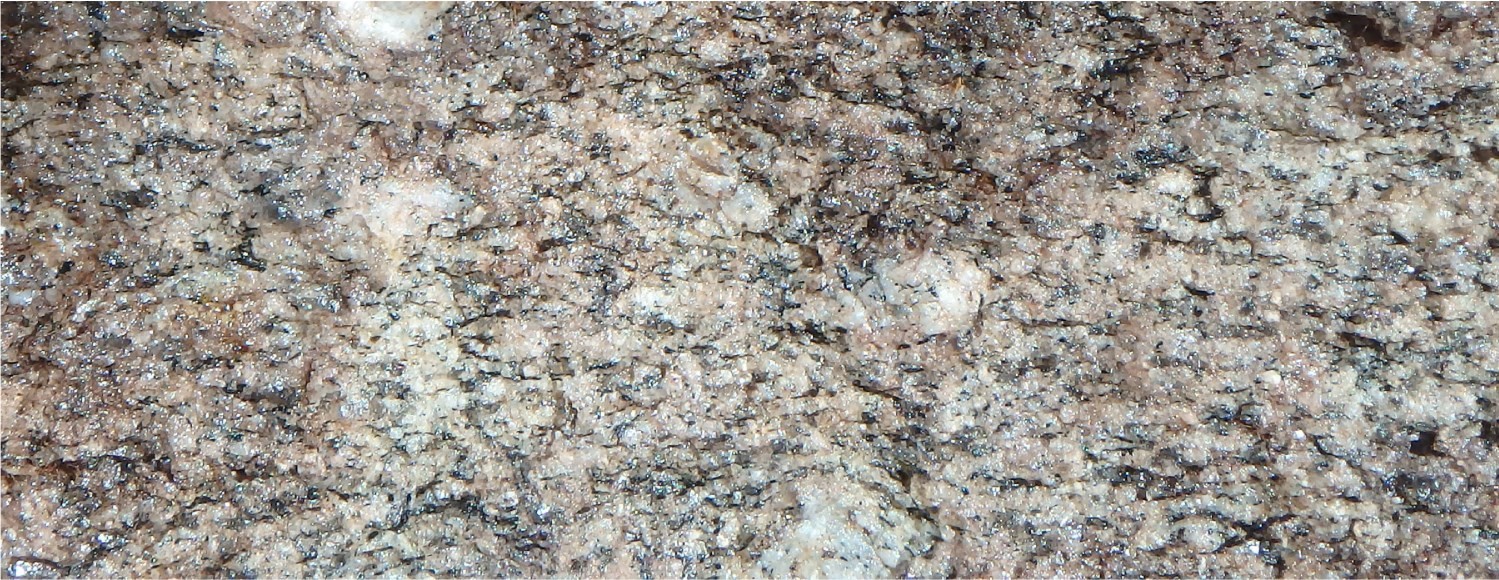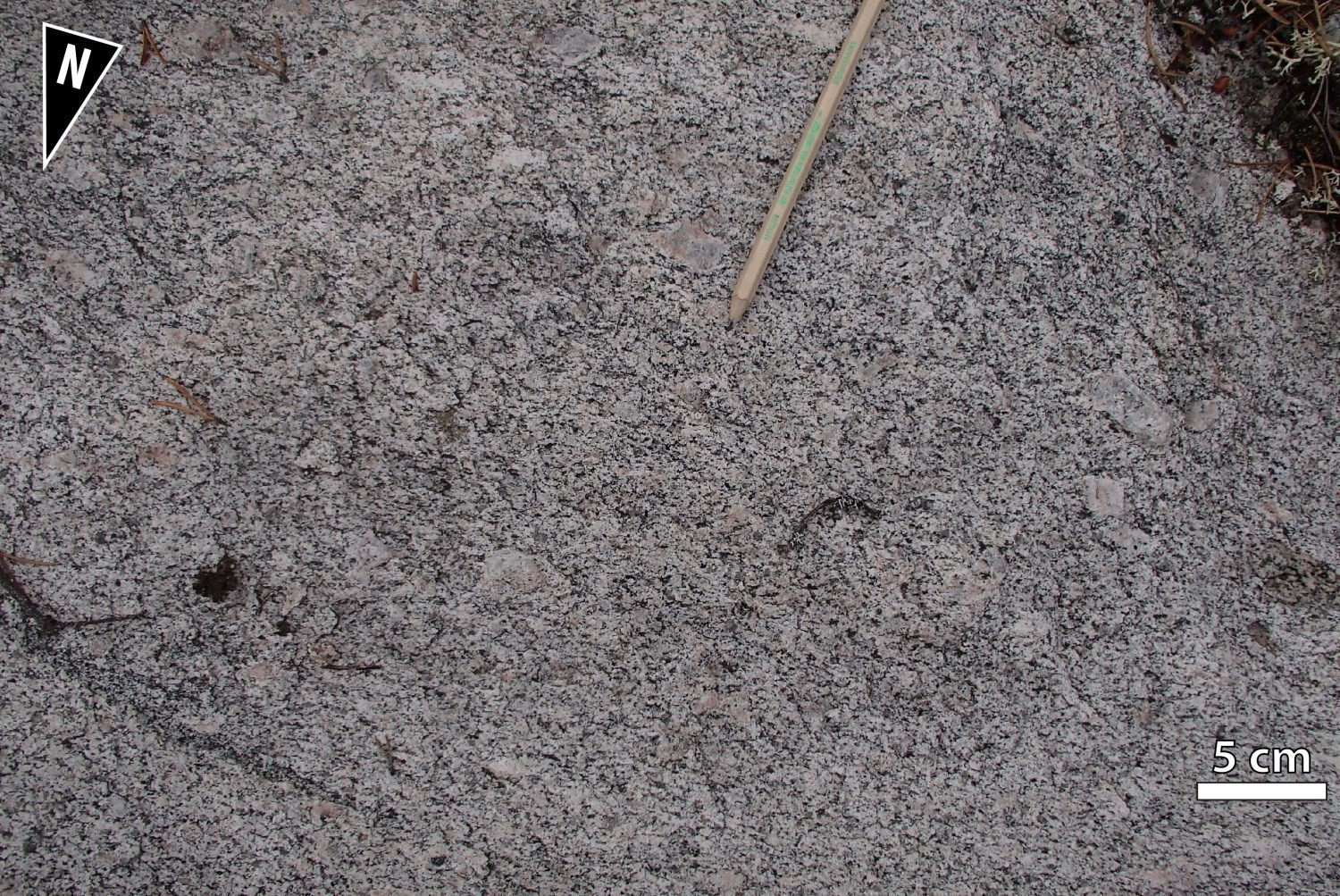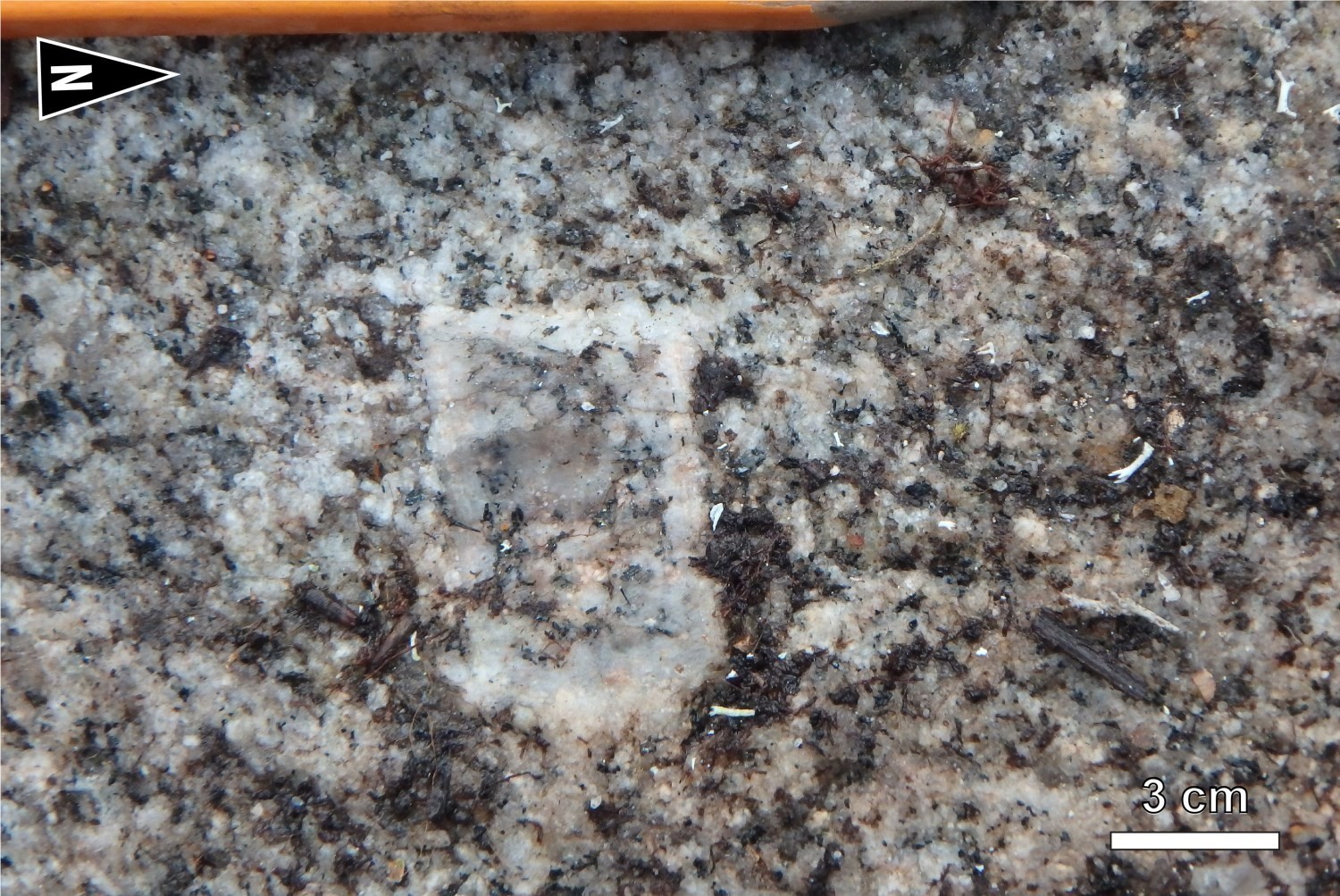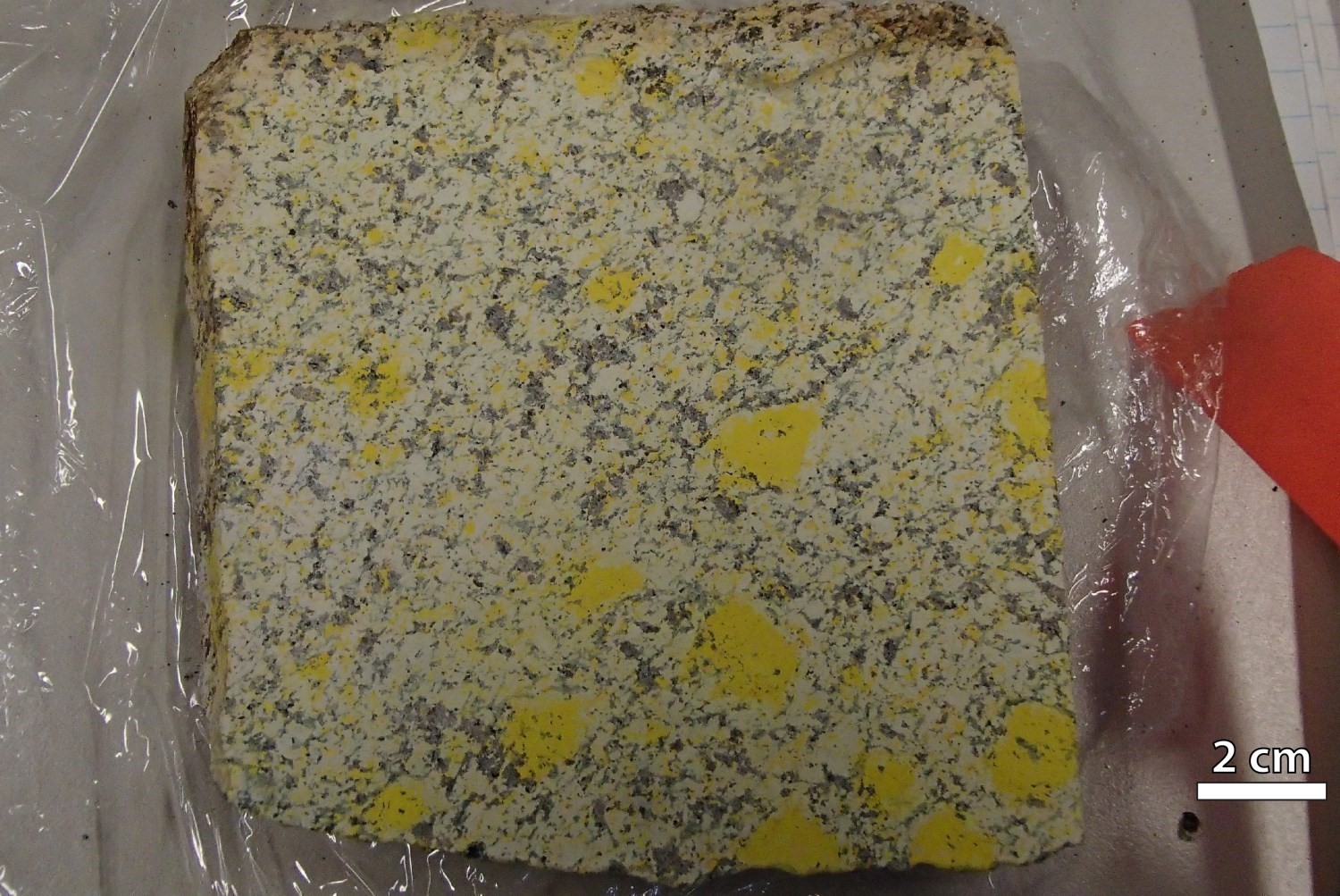
Last modified: 4 December 2020
DISCLAIMER: This English version is translated from the original French. In case of any discrepancy, the French version shall prevail.
| Author: | Beauchamp et al., 2018 |
| Age: | Neoarchean |
| Stratotype: | None |
| Type area: | Bohier Island and Cadieux Lake areas (NTS sheets 32A02, 33A07 and 33A08) |
| Geological province: | Superior Province |
| Geological subdivision: | Opatica Subprovince |
| Lithology: | Porphyraceous granodiorite, quartz monzodiorite and monzodiorite |
| Category: | Lithodemic |
| Rank: | Suite |
| Status: | Formal |
| Use: | Active |
None
Background
Hocq (1985) introduced the 485 km2 Lac Cadieux Massif between the Upper Eastmain Greenstone Belt (UEGB) and the Eastmain River during its work. This large felsic to intermediate package is described as mostly granodioritic. Later, Roy (1988) clarified the nature of this massif and introduced the Lac Cadieux Granodiorite, described as banded and slightly porphyritic. Beauchamp et al. (2018) refined the nomenclature of this unit and renamed it the Cadieux Pluton. Since two additional intrusive masses were identified in sheets 33A08, 33A07 and 33A02, the Cadieux Pluton became the Cadieux Suite (Beauchamp, 2020).
Description



 The Cadieux Suite consists mainly of quartz monzodiorite and granodiorite. The unit is very homogeneous and is easily distinguishable from other rocks in the area, particularly by its K-feldspar porphyraceous texture. Zoned phenocrystals are 1 to 3 cm long and may represent 1 to 20% of the rock, with the remainder of the rock being medium grained. The rock is grey-white in altered surface and grey-pink in fresh exposure. The Sn foliation is prominent and marked by the alignment of ferromagnesian minerals along flattening planes. The main ferromagnesian minerals are biotite (1-15%), hornblende (1-10%) and magnetite. Sphene is commonly observed (1-3%). In thin section, epidote and allanite (locally zoned) are present. The rock’s magnetism varies from moderate to strong depending on the amount of magnetite present. The main alterations affecting the rock are mild chloritization and weak hematization.
The Cadieux Suite consists mainly of quartz monzodiorite and granodiorite. The unit is very homogeneous and is easily distinguishable from other rocks in the area, particularly by its K-feldspar porphyraceous texture. Zoned phenocrystals are 1 to 3 cm long and may represent 1 to 20% of the rock, with the remainder of the rock being medium grained. The rock is grey-white in altered surface and grey-pink in fresh exposure. The Sn foliation is prominent and marked by the alignment of ferromagnesian minerals along flattening planes. The main ferromagnesian minerals are biotite (1-15%), hornblende (1-10%) and magnetite. Sphene is commonly observed (1-3%). In thin section, epidote and allanite (locally zoned) are present. The rock’s magnetism varies from moderate to strong depending on the amount of magnetite present. The main alterations affecting the rock are mild chloritization and weak hematization.
 Intrusions of leucocratic, massive to slightly foliated, pink biotite ± magnetite ± hornblende granite cut most outcrops of the Cadieux Suite. Small enclaves of hornblende-biotite-magnetite diorite are present in small proportions in rocks of this suite. These lithological units are not mappable at this scale.
Intrusions of leucocratic, massive to slightly foliated, pink biotite ± magnetite ± hornblende granite cut most outcrops of the Cadieux Suite. Small enclaves of hornblende-biotite-magnetite diorite are present in small proportions in rocks of this suite. These lithological units are not mappable at this scale.
From a lithogeochemical perspective (Beauchamp, 2020), the Cadieux Suite rocks are of calc-alkaline affinity (Frost et al., 2001). They are generally metaluminous and type I (Maniar and Picolli, 1989). They plot into the field of volcanic arc granites (Pearce et al., 1984). The rare earth profile does not have any particular anomaly and shows light rare earth enrichment relative to heavy rare earths. Rocks of the Cadieux Suite are less magnesian and slightly richer in light rare earths than those of the Macleod Batholith and the Lépante Suite. The spider diagram nomalized to the CI chondrite (McDonough and Sun, 1995) shows negative anomalies in Nb, Ta, P and Ti, and positive anomalies in La, Ce and Nd.
Thickness and Distribution
There are two occurrences of the Cadieux Suite in NTS sheets 33A08 and 33A07. The first, located in the northern portion, has an oval shape with an 8 km small axis and a 15 km long axis, around which basalts of the René Group are moulded. The Lac Hécla Anticline crosses the core of the pluton parallel to the long axis. The second occurrence follows the entire south side of the west branch of the UEGB, from the south of Bohier Island, in the east, to sheet 33A07, in the west. It makes a turn to the NW and surrounds the western end of the UEGB.
Dating
Two samples of the Cadieux Suite (17-JM-6059A and 18-AB-1078A) were collected for U-Pb isotopic dating during the 2017 and 2018 campaigns. Depending on crystallization ages obtained, the Cadieux Suite intruded between 2699 ±5 Ma (Davis and Sutcliffe, 2018) and 2700 ±3 Ma (Davis, 2019).
| Unit | Sample Number | Isotopic System | Mineral | Crystallization Age (Ma) | (+) | (-) | Metamorphic Age (Ma) | (+) | (-) | Reference(s) |
| nAcad | 2017-JM-6059A | U-Pb | Zircon | 2699 | 5 | 5 | Davis and Sutcliffe, 2018 | |||
| 2018-AB-1078A | U-Pb | Zircon | 2700 | 3 | 3 | Davis, 2019 | ||||
| Titanite | 2651 | 14 | 14 |
Stratigraphic Relationship(s)
The Cadieux Suite cuts several Mesoarchean to Neoarchean units in the Cadieux Lake and Bohier Island area, including gneissic and intrusive rocks of the Misasque Complex, the Digne Pluton, volcanic rocks of the René Group, sedimentary rocks of the Bohier Group, the Macleod Batholith and migmatized paragneiss of the Laguiche Complex.
An episode of significant plutonism between 2705 Ma and 2699 Ma contributed to the emplacement of several intrusive masses in the Cadieux Lake and Bohier Island area. This period corresponds to the magmatic crystallization age of the Mabille Complex tonalitic unit (nAmbi1), Macleod Batholith and Cadieux Suite.
Paleontology
Does not apply.
References
Publications available through SIGÉOM Examine
BEAUCHAMP, A M. 2020. Géologie de la région du lac Cadieux, sous-provinces d’Opatica et d’Opinaca, Eeyou Istchee Baie-James, Québec, Canada. MERN. BG 2019-02, 1 plan.
BEAUCHAMP, A M., MASSEI, F., DAOUDENE, Y. 2018. Géologie de la région de l’île Bohier, au contact entre les sous-provinces d’Opatica, d’Opinaca et le bassin d’Otish, au nord de Mistissini, Eeyou Istchee Baie-James, Québec, Canada. MERN. BG 2018-02, 2 plans.
DAVIS, D W., SUTCLIFFE, C N. 2018. U-Pb Geochronology of Zircon and Monazite by LA-ICPMS in Samples from Northern Quebec. UNIVERSITY OF TORONTO. MB 2019-01, 113 pages.
HOCQ, M. 1985. GEOLOGIE DE LA REGION DES LACS CAMPAN ET CADIEUX, TERRITOIRE-DU-NOUVEAU-QUEBEC. MRN. ET 83-05, 190 pages et 4 plans.
ROY, C. 1988. GEOLOGIE DU SECTEUR DE L’ILE BOHIER DE LA BANDE VOLCANOSEDIMENTAIRE DE LA RIVIERE EASTMAIN SUPERIEURE. MRN. MB 88-16, 115 pages et 5 plans.
Other publications
FROST, B.R., BARNES, C.G., COLLINS, W.J., ARCULUS, R.J., ELLIS, D.J., FROST, C.D. 2001. A geochemical classification for granitic rocks. Journal of Petrology; volume 12, numéro 11, pages 2033-2048. https://doi.org/10.1093/petrology/42.11.2033
MANIAR, P.D., PICCOLI, P.M. 1989. Tectonic discrimination of granitoids. Geological Society of America Bulletin; volume 101, pages 635-643. https://doi.org/10.1130/0016-7606(1989)101
MCDONOUGH, W.F., SUN, S.S. 1995. The composition of the Earth. Chemical Geology; volume 120, pages 223-253. https://doi.org/10.1016/0009-2541(94)00140-4
PALME, H., O’NEILL, H.S.C. 2004. Cosmochemical estimates of mantle composition. In Treatise on Geochemistry. (Holland, H.D. and Turrekian, K.K. editors), Elsevier, Amsterdam, The Netherlands; volume 2, pages 1-38. http://doi.org/10.1016/B978-0-08-095975-7.00201-1
PEARCE, J.A., HARRIS, N. W., TINDLE, A.G. 1984. Trace element discrimination diagrams for the tectonic interpretation of granitic rocks. Journal of Petrology; volume 25, pages 956-983. https://doi.org/10.1093/petrology/25.4.956
Suggested Citation
Ministère de l’Énergie et des Ressources naturelles (MERN). Cadieux Suite. Quebec Stratigraphic Lexicon. https://gq.mines.gouv.qc.ca/lexique-stratigraphique/province-du-superieur/suite-de-cadieux_en [accessed on Day Month Year].
Contributors
|
First publication |
Frédéric Massei, P. Geo., M.Sc. frederic.massei@mern.gouv.qc.ca (redaction) Mehdi A. Guemache, P. Geo., Ph.D. (coordination); Mélina Langevin, B.Sc. (critical review); Simon Auclair, P. Geo., M.Sc. (editing); Céline Dupuis, P. Geo., Ph.D. (English version); Nathalie Bouchard and Ricardo Escobar Moran (HTML editing). |
|
Revision(s) |
Anne-Marie Beauchamp, Eng., M.Sc. anne-marie.beauchamp@mern.gouv.qc.ca (redaction) Mehdi A. Guemache, P. Geo., Ph.D. (coordination); Patrice Roy, P. Geo., M.Sc. (critical review); Simon Auclair, P. Geo., M.Sc. (editing); Céline Dupuis, P. Geo., Ph.D. (English version); Ricardo Escobar Moran (HTML editing). |

